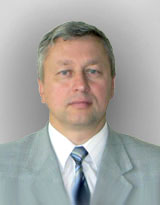СЕГМЕНТАЦИЯ ОБЪЕКТОВ НА БИОМЕДИЦИНСКИХ ИЗОБРАЖЕНИЯХ С ИСПОЛЬЗОВАНИЕМ БИБЛИОТЕКИ ШАБЛОНОВ
Аннотация
Рассматривается система компьютеризированной диагностики для обнаружения объектов с произвольными размерами и формой и сегментации их на медицинских изображениях различной мо-дальности с использованием библиотеки шаблонов нерегулярной гладкой формы.
Об авторах
М. М. АлилуРоссия
М. В. Спринджук
Россия
Список литературы
1. Yoo, T.S. Insight into images: principles and practice for segmentation, registration, and image analysis / T.S. Yoo. – Wesllesley, Massachusetts : A. K. Peters, 2004. – P. 100–120.
2. Borenstein, E. Class-specific, top-down segmentation / E. Borenstein, S. Ullman // Computer Vision ECCV. – 2002. – Vol. 2. – P. 639–641.
3. Levin, A. Learning to combine bottom-up and top-down segmentation / A. Levin, Y. Weiss // Computer Vision ECCV. – 2006. – Vol. 1. – P. 581–594.
4. Leibe, B. Pedestrian detection in crowded scenes / B. Leibe, E. Seemann, B. Schiele // IEEE. – 2005. – Vol. 2. – P. 878–885.
5. Ferrari, V. Object detection by contour segment networks / V. Ferrari, T. Tuytelaars, L. Van Gool // Computer Vision ECCV. – 2006. – Vol. 3. – P. 14–28.
6. Kokkinos, I. Bottom-up & top-down object detection using primal sketch features and graphical models / I. Kokkinos, P. Maragos, A. Yuille // IEEE. – 2006. – Vol. 7. – P. 1893–1900.
7. Zhao, L. Closely coupled object detection and segmentation / L. Zhao, L.S. Davis // IEEE. –2005. – Vol. 6. – P. 454–461.
8. Ren, X. Recovering human body configurations using pairwise constraints between parts /X. Ren, A.C. Berg, J. Malik // IEEE. – 2005. – Vol. 5. – P. 824–831.
9. Recovering human body configurations: Combining segmentation and recognition / G. Mori [et al.] // IEEE. – 2004. – Vol. 2. – P. 323–326.
10. Srinivasan, P. Bottom-up recognition and parsing of the human body / P. Srinivasan, J. Shi // CVPR. – USA : Springer, 2007. – P. 153–168.
11. Felzenszwalb, P.F. Pictorial structures for object recognition / P.F. Felzenszwalb, D.P. Huttenlocher // International Journal of Computer Vision. – 2005. – Vol. 61, № 1. – P. 55–79.
12. Segmentation of pulmonary nodules in thoracic CT scans: a region growing approach / J. Dehmeshki [et al.] // Medical Imaging, IEEE Transactions on. – 2008. – Vol. 27, № 4. – P. 467–480.
13. Quantitative surface characterization of pulmonary nodules based on thin-section CT images / Y. Kawata [et al.] // Nuclear Science, IEEE Transactions on. – 1998. – Vol. 45, № 4. – P. 2132–2138.
14. Segmentation of nodules on chest computed tomography for growth assessment / W. Mullally [et al.] // Medical physics. – 2004. – Vol. 31. – P. 839.
15. Jain, A.K. Object matching using deformable templates / A.K. Jain, Y. Zhong, S. Lakshmanan // Pattern Analysis and Machine Intelligence, IEEE Transactions on. – 1996. – Vol. 18, № 3. – P. 267–278.
16. Deformable Organisms: An Artificial Life Framework for Automated Medical Image Analysis / G. Hamarneh [et al.] // Computational Intelligence In Medical Imaging : Techniques and Applications. – 2009. – Vol. 1. – P. 433.
17. A method for identification and visualization of histological image structures relevant to the cancer patient conditions / V. Kovalev // Computer Analysis of Images and Patterns. – 2011. – Vol. 6854, № 1. – P. 460–468.
Рецензия
Для цитирования:
Алилу М.М., Спринджук М.В. СЕГМЕНТАЦИЯ ОБЪЕКТОВ НА БИОМЕДИЦИНСКИХ ИЗОБРАЖЕНИЯХ С ИСПОЛЬЗОВАНИЕМ БИБЛИОТЕКИ ШАБЛОНОВ. Информатика. 2013;(4):23-29.
For citation:
Alilou M.M., Sprindzuk M.V. SEGMENTATION OF OBJECTS ON BIOMEDICAL IMAGES USING LIBRARIES OF TEMPLATES. Informatics. 2013;(4):23-29. (In Russ.)

























